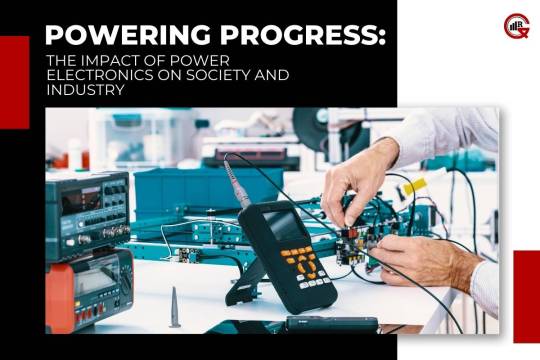#SustainableEnergyFuture
Text
Powering Progress: The Impact of Power Electronics on Society and Industry

Power electronics is a rapidly evolving field that plays a crucial role in modern electrical systems, ranging from consumer electronics to industrial applications. This article explores the fundamentals of power electronics, its applications, recent advancements, and its significance in shaping the future of electrical engineering.
Power electronics is a branch of electrical engineering that deals with the control and conversion of electric power. It involves the design, analysis, and implementation of electronic circuits and devices to efficiently convert and control electrical energy. Power electronic devices such as rectifiers, inverters, converters, and voltage regulators are essential components in various electrical systems, enabling the efficient management and utilization of electrical power.
Fundamentals of Power Electronics:

At the heart of electronics are semiconductor devices such as diodes, transistors, and thyristors, which are used to control the flow of electrical current. These devices operate in different switching modes, including rectification, inversion, and regulation, to achieve desired power conversion tasks. Key concepts in electronics include voltage regulation, current control, power factor correction, and harmonic mitigation, all of which are essential for optimizing the performance and efficiency of electrical systems.
Applications of Power Electronics:
Power electronics finds applications in diverse fields, including:
Renewable Energy Systems: Power electronic converters are used in renewable energy systems such as solar photovoltaic (PV) and wind turbines to convert DC power generated by solar panels and wind turbines into AC power suitable for grid integration.
Electric Vehicles (EVs): Power electronic converters control the charging and discharging of batteries in electric vehicles, as well as the conversion of DC power from batteries to AC power for driving electric motors.
Industrial Automation: Power electronic devices are widely employed in industrial automation systems for motor control, variable speed drives, and power distribution, enabling efficient operation and energy savings in industrial processes.
Power Supplies: Switch-mode power supplies (SMPS) based on power electronic converters are used in electronic devices, computers, and telecommunications equipment to provide regulated DC voltage from AC mains power.
Consumer Electronics: Power electronic circuits are integral to the operation of various consumer electronics such as LED lighting, home appliances, mobile devices, and audio amplifiers, providing efficient power conversion and control.
Recent Advancements:

Recent advancements in power electronics have focused on improving efficiency, reliability, and integration in electrical systems. Some notable developments include:
Wide Bandgap (WBG) Semiconductor Devices: WBG materials such as silicon carbide (SiC) and gallium nitride (GaN) offer superior electrical properties compared to traditional silicon devices, enabling higher operating temperatures, lower switching losses, and higher power density in power electronic converters.
Digital Control Techniques: Digital control algorithms and microcontroller-based control systems provide enhanced flexibility, accuracy, and performance in power electronic converters, enabling advanced features such as adaptive control, predictive maintenance, and grid integration.
Multi-Level Converter Topologies: Multi-level converter topologies such as modular multilevel converters (MMC) and cascaded H-bridge converters offer improved voltage waveform quality, reduced harmonic distortion, and enhanced fault tolerance in high-voltage AC and DC power transmission systems.
Energy Storage Systems: Power electronic converters are integral components of energy storage systems such as battery energy storage systems (BESS) and supercapacitors, enabling efficient charging, discharging, and management of electrical energy in grid-connected and off-grid applications.
Smart Grid Technologies: Power electronics play a crucial role in smart grid technologies such as smart meters, grid-tied inverters, and demand response systems, enabling bidirectional power flow, voltage regulation, and real-time monitoring and control of electrical networks.
Significance:

Power electronics are essential for achieving energy efficiency, reliability, and sustainability in modern electrical systems. By enabling efficient power conversion, control, and management, power electronics contributes to reduced energy consumption, lower greenhouse gas emissions, and improved grid stability. As the demand for energy-efficient technologies and renewable energy sources continues to grow, the importance of power electronics in shaping the future of electrical engineering and sustainable energy systems cannot be overstated.
Integration with Internet of Things (IoT): Power electronics is increasingly being integrated with IoT technologies to enable smart and connected electrical systems. IoT-enabled power electronic devices and sensors allow for remote monitoring, diagnostics, and control of electrical equipment, improving operational efficiency and reliability.
High-Frequency Power Conversion: Advancements in high-frequency power conversion techniques have led to the development of compact and lightweight power electronic systems with higher power density and efficiency. High-frequency switching converters and resonant power circuits enable efficient power conversion in applications such as wireless power transfer, electric vehicle chargers, and high-frequency lighting systems.
Resilience to Electromagnetic Interference (EMI): Power electronic systems are designed to mitigate electromagnetic interference (EMI) to ensure reliable operation in electromagnetic environments. EMI filters, shielding techniques, and electromagnetic compatibility (EMC) standards are employed to reduce electromagnetic emissions and susceptibility, ensuring compliance with regulatory requirements and maintaining system reliability.
Energy Harvesting and Wireless Power Transfer: Power electronics are instrumental in energy harvesting systems that capture and convert ambient energy sources such as solar, thermal, and kinetic energy into usable electrical power. Wireless power transfer technologies based on power electronic resonant circuits enable efficient transmission of electrical energy over short and long distances, supporting applications such as wireless charging, sensor networks, and implantable medical devices.
Environmental Sustainability: Power electronics play a vital role in promoting environmental sustainability by enabling the integration of renewable energy sources, energy storage systems, and efficient power management strategies. By facilitating the adoption of clean and renewable energy technologies, power electronics contribute to reducing greenhouse gas emissions, mitigating climate change, and promoting a transition towards a low-carbon economy.
Conclusion:
Power electronics is a dynamic and interdisciplinary field that underpins the design and operation of modern electrical systems across various applications. With ongoing advancements in semiconductor technology, digital control techniques, and energy storage systems, power electronics continues to drive innovation and transformation in renewable energy, electric transportation, industrial automation, and consumer electronics. As we look towards a future powered by clean and sustainable energy, power electronics will play a central role in realizing this vision through efficient power conversion, integration, and management.
#PowerElectronicsInnovation#RenewableEnergyConversion#SmartGridSolutions#HighFrequencyPowerTech#SustainableEnergyFuture
0 notes
Text
Empowering Energy Evolution: Unleashing AI's Revolutionary Impact on Production
Originally Published on: QuantzigEnhance Production and Discover New Energy Projections with AI
Exploring Advanced AI-Driven Energy Management
In the ever-evolving realm of industrial production, the integration of Artificial Intelligence (AI) emerges as a catalyst for revolutionary change. This article explores the profound impact of AI on production processes and the unveiling of innovative energy projections. As industries navigate complexities with a focus on sustainability, AI becomes the linchpin, optimizing manufacturing workflows and offering unparalleled insights into energy dynamics. From predictive maintenance to demand forecasting, AI-driven solutions play a pivotal role in fostering efficiency and sustainability. Embark on a journey through the AI landscape, where innovation converges with production, shaping a future where industries pioneer advancements in energy utilization.
Overview
In the landscape of energy production and management, the integration of AI stands as a transformative strategy. Energy firms embrace digitalization for real-time network monitoring, utilizing advanced measurement tools for impact assessment, decision support, and rapid resolutions. This shift towards digital technologies facilitates a granular understanding of supply and demand dynamics, empowering energy firms to balance and optimize production seamlessly.
Top Areas for AI-Enhanced Energy Management
Data Digitalization & Digital Twins:
Implementation of AI-driven strategies for data digitalization.
Creation and utilization of digital twins for comprehensive energy infrastructure modeling.
Production Management & Failure Prevention:
AI-enhanced production management streamlining operations.
Predictive maintenance preventing failures and ensuring uninterrupted energy production.
Sustainability & Renewable Energy:
Integration of AI for sustainable energy practices.
Optimization of renewable energy sources through AI-driven insights and projections.
Benefits
Impact Measurement, Critical Resolution, and Faster Remediations:
AI enables precise measurement of energy operation impacts.
Real-time critical issue resolution ensures faster remediations.
AI’s analytical capabilities provide comprehensive insights for proactive responses.
Streamlined Production with Higher Capacity Utilization and Increased Energy Throughput:
AI optimizes operational workflows, predicting disruptions for higher capacity utilization.
Improved efficiency, reduced downtime, and enhanced overall productivity result from AI-driven insights.
Easier Management of Carbon Emission Compliances:
AI manages carbon emission compliances effectively.
Accurate data analysis and monitoring ensure adherence to environmental regulations.
AI-driven tools provide insights for sustainable practices, minimizing carbon footprints.
The Future of AI in Energy Management
The future promises a shift towards sustainable production, streamlined operations, real-time resolutions, and data-driven insights at an individual device level. AI technologies are set to revolutionize the energy sector by enabling sustainable practices, minimizing environmental impact, and ensuring efficient resource utilization.
Statistics
The global AI energy market is projected to experience significant growth, with a compound annual growth rate (CAGR) of 28% over the next decade. This expansion underscores the increasing adoption and impact of artificial intelligence in the energy sector.
In conclusion, the integration of AI technologies in the energy sector heralds a transformative era, enabling digitalization, real-time monitoring, and sustainable practices. As AI continues to advance, its role in shaping the future of energy production and management remains pivotal.
Contact us.
0 notes
Text
£6bn Boost for UK's Energy Efficient Future

The Energy Efficiency Scheme
In a groundbreaking move, the UK Government has announced a significant £6 billion allocation to revolutionize energy use and reduce bills for around a million homes and hundreds of businesses. This initiative is a critical component of the UK's approach to achieving net zero, aiming to make energy consumption more efficient and cost-effective for the public.
Benefits for Families and Businesses
Families across the UK will experience direct benefits from this funding, with measures like insulation for approximately 500,000 homes and additional grants for heat pumps. The Prime Minister's recent increase in the heat pump grant to £7,500 has already led to a 57% spike in applications, demonstrating the scheme's success and public interest.
Energy Secretary Claire Coutinho emphasized that cutting energy bills remains a top priority, with this funding poised to assist those most in need, particularly during the colder months. The scheme is expected to extend its reach to 200,000 cold, low-income, and social homes.
Driving Towards Energy Security and Efficiency
Chancellor's Perspective on Energy Independence
Chancellor of the Exchequer Jeremy Hunt highlighted the importance of this investment in energy efficiency as a strategic move to mitigate the impact of international gas prices, a major inflation driver. This investment supports households and businesses in making greener choices without adding financial burdens.
Progress in Energy Performance
The government's commitment is evident in the progress made thus far, with nearly 50% of properties in England now holding an Energy Performance Certificate of C – a significant increase from just 14% in 2010.
Industry Leaders' Support and Insights
Octopus Energy's CEO on Heat Pumps
Greg Jackson, CEO of Octopus Energy, praised the increasing affordability and installation efficiency of heat pumps, noting the technology as the future of heating. Octopus Energy's plan to hire two thousand new engineers next year reflects the growing demand for this technology.
Energy Saving Trust on the Importance of Efficiency
Mike Thornton, Chief Executive at the Energy Saving Trust, acknowledged the necessity of improving home energy efficiency and electrifying heat to reduce reliance on imported fossil fuels and achieve the UK’s net zero targets. He welcomed the new schemes and funding, anticipating further details on rollout and engagement plans.
Future-Proofing New Homes and Buildings
Zero-Carbon Ready Homes by 2025
Under new plans, all new homes and buildings will be zero-carbon ready from 2025, avoiding additional future-proofing costs for families. The Future Homes and Buildings Standards aim to reduce carbon emissions by at least 75% for all new homes compared to 2013 standards.
Extending the Government's Commitment
The government's announcement exceeds its manifesto commitment of £9.2 billion for energy efficiency by 2030, now committing to spend £12.6 billion by 2028. This funding will support green jobs and help homes, hospitals, schools, and businesses save money.
A Comprehensive Approach to Energy Efficiency
Upcoming Energy Efficiency Schemes
Several schemes are in the pipeline, subject to business case approval and value assessments, including the Boiler Upgrade Scheme, a new £400 million energy efficiency grant, local authority retrofit schemes, the Social Housing Decarbonisation Fund, and the Green Heat Network Fund. These initiatives will collectively support the transition to a more energy-efficient and low-carbon future.
Expanding Heat Networks
The government is also exploring ways to expand heat networks to deliver low-carbon heating to homes and businesses in England, ensuring families benefit from local, clean heat at fair prices.
The UK's Energy Strategy
This £6 billion investment marks a milestone in the UK’s journey towards a sustainable and energy-efficient future. It not only addresses immediate needs but also lays the groundwork for long-term, cost-effective, and environmentally friendly energy solutions.
Sources: THX News, Department for Energy Security and Net Zero, HM Treasury, The Rt Hon Claire Coutinho MP, & The Rt Hon Jeremy Hunt MP.
Read the full article
#EnergyBillsReduction#EnergyPerformanceCertificates#EnergySecurityInvestment#GreenJobsSupport#HeatPumpGrantsIncrease#HomeInsulationFunding#Low-CarbonHeatingSolutions#NetZeroTargets#SustainableEnergyFuture#UKEnergyEfficiencyScheme
0 notes
Text
China's rising woo in the white oil industry

China's aggressive push to capture a significant share of the white oil market, fueled by growing demand for lithium used in electric vehicle batteries, is raising concerns in developed countries. China's extensive investments in lithium mines around the world and its goal to control one-third of the world's lithium production by 2025 present challenges for other countries.
The global response to China's white milk dominance
China's surge in investment in lithium mines has raised concerns among developed countries, especially those heavily involved in the electric vehicle industry. There are several key issues that developed countries need to address.As tensions between China and the U.S. escalate, concerns are rising about the potential for supply chains for key minerals, including lithium, to be disrupted. Developed countries are increasingly wary of relying heavily on resources controlled by China for strategic industries.Countries such as Canada and Australia have begun to impose restrictions on Chinese investment in lithium due to national security concerns.The fear of China exerting undue influence on the global lithium market poses a challenge to these countries as they seek to maintain control over their mineral resources.
Implications and future outlook
China has a significant share of lithium production and can therefore exert significant influence on lithium prices, which can affect the overall cost of electric vehicle batteries. This dynamic affects the competitiveness and affordability of electric vehicles in the global market.Disruptions in the supply chain due to geopolitical tensions or changes in Chinese policy can lead to shortages and price fluctuations. Developed countries should prepare for such a scenario to minimize disruption to their domestic industries.China's investments in emerging countries to secure lithium mines could strengthen its influence in the region. This could have long-term geopolitical consequences and potentially affect global power dynamics.
#WhiteOilIndustry#LithiumDemand#ChinaLithiumInvestments#ElectricVehicleRevolution#SupplyChainSecurity#DiversificationStrategies#GlobalResourcePolitics#GeopoliticalImplications#SustainableEnergyFuture#LithiumAlliances
0 notes
Photo

Importance of Mindful Electricity Consumption for a Sustainable Energy Future
It is extremely important to be mindful of the amounts of electricity we consume and the ways in which it is consumed. A sustainable energy future is achievable only with sensible usage.
0 notes